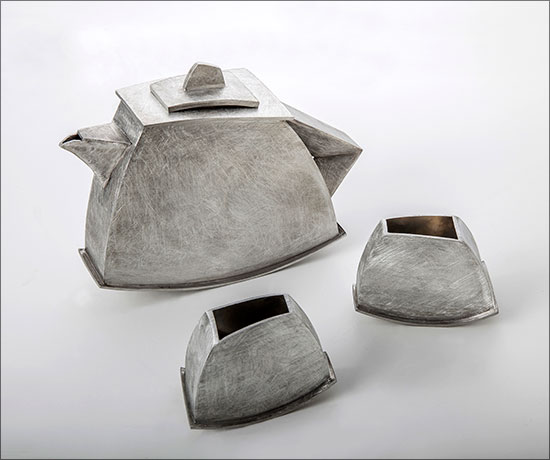Materials: Hand-fabricated pewter
Dimensions: Teapot: 4.75" x 6" x 2.75" (holds exactly 8 oz); Cups: 2" x 2.75" x 1.75"
This piece is a bit different than all of my other work. I wanted to make a functional piece that I could use in everyday life. Although a ‘teapot’ by name, this rocking vessel (and its rocking mini cups) can hold a variety of my favorite morning and evening beverages. It is the life of the party. It is… The Notorious Teapot.
Photo credit: Tom Burazin
Holland Houdek
Syracuse, New York. USA
Holland Houdek is currently an adjunct professor in the department of Jewelry and Metalsmithing at Syracuse University, where she also earned her MFA. Her work can be seen in Lark Books: 500 Rings, Lark Books: 500 Felt Objects, SNAG’s The Body Adorned, Art Buzz 2012 and 2013, and other publications. She has shown in galleries and museums throughout the United States and recently had work in an exhibition in Berlin. Holland’s concept-driven work comments on various themes surrounding the mind-body relationship as she continues to engage the dialogue of contemporary metalsmithing, jewelry and installation. Her current work focuses on governmental regulations on medical implants and how they affect the lives of people in developing and third world countries.
These containers and vessels definitely hold their place in the world of stunning art objects as well as in the world of metalsmithing.
Since the dawn of time humans have created containers to hold things that were important to them, from large vessels to hold food and harvests to intimate containers for small precious things. They might hold memories, ashes, medicine, beverage, fruit or food - but all spring from the imagination and skill of the maker. Some have specific religious functions, some are meant for everyday use. When one thinks of a vessel or container the inclination is to think of something with solid walls - yet many of these works involve the exploration of positive and negative space, and the use of negative space to help create the illusion of the wall of the vessel.
As the world’s largest jewelry related internet site, Ganoksin strives to develop exhibitions showcasing work from around the world. This exhibition was open to all metalsmiths, professional and amateur, advanced and beginner. Participants are from The Netherlands, the USA, Canada, Australia, Costa Rica, the United Kingdom, Israel, Hong Kong, Colombia, Romania, Italy, Ireland, Japan, Malaysia and Denmark. While most of the pieces are by an individual metalsmith, some are collaborations, one of three artists spanning 50 years.
In total 319 artists contributed 729 show pieces for the permanent online exhibition.
Objects in the exhibition include boxes, lockets, urns, ash containers, bowls, wine cups, reliquaries, match holders, vases, teapots, pitchers, sugar bowls, baskets, nests, pillboxes, clutches and a range of sculptural forms. A variety of techniques are showcased covering a wide range of metalsmithing techniques. Materials used include everything from gold and silver to less expensive metals. Ornamentation includes the addition of enamel, chasing and repousse’, gemstones and found objects.
The exhibition was curated by Beth Wicker, President of the North Carolina Society of Goldsmiths in the United States, and Adjunct Instructor at Northeastern Technical College in South Carolina. Director of the exhibition is Hanuman Aspler, founder of The Ganoksin Project, the world’s largest internet jewelry site.
